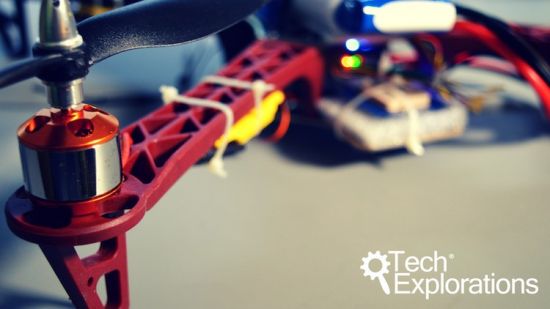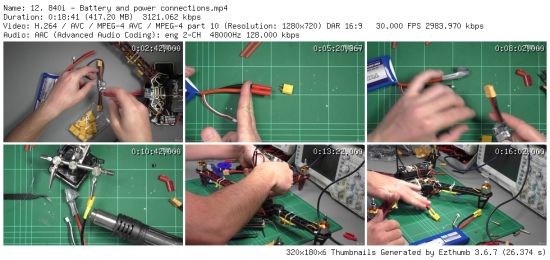السلام عليكم اخواني
الرجاء منكم تحويل روابط هذا الكورس الى روابط مباشرة
Tech Explorations™ Make an Open Source Drone

MP4 | Video: AVC 1280x720 | Audio: AAC 48KHz 2ch | Duration: 8 Hours | Lec: 85 | 5.13 GB | Genre: eLearning | Language: English | Sub: English
A fun project in which you learn about drones by making one. Use the Pixhawk or Multiwii AIO flight controllers
What you'll learn
understand the types of multi-rotor drones
understand flight terminology
understand the principles of drone flight
understand the roles of propellers, motors, flight controller, ESC in drone flight
understand the use of LiPo batteries and their use
understand the use of GPS in drone flight
understand how to bind a radio receiver and transmitter
understand the necessary drone pre-flight checks
understand the basic safety and legal requirements involved in recreational drone flight
assemble a quadcopter from parts available in the market
upload the MultiPirateNG firmware to the Crius V2 flight controller
use the open source Mission Planner software to configure a drone
practice flying their quadcopter and fun while becoming better pilots!
Requirements
Windows computer
Basic electronics tools (please see free list of tools in section 1)
Be comfortable working with electronic components
Willingness to persevere despite set-downs (like broken propellers resulting from a drone rough landing)
Description
Welcome to "Make an Open Source Drone", a course that will teach you how to build a quadcopter from scratch!
Playing with drones, and especially quadcopters, is fast becoming a very popular hobby. As a hobby, it combines state of the art open technology with large open spaces. It even gives me a great excuse to get out of my lab and get some sun!
While you can just go to a shop and purchase a drone that is ready to fly, by doing so you miss out on all the fun and knowledge that comes with building your own flying machine. I admit I have done that myself. Getting my ready-to-fly drone out of its box and flying it was fun, but only for a short period.
Soon after the first excitement settled, I realised that I didn't know much more than before I opened the box. I was also unable to do anything more than what the drone was programmed to do, to begin with.
That is why making your own open source drone is such a great way to have fun while learning.
in this course, my co-instructor Aristofanis and I will help you understand drones and how to build them. You will learn about their mechanical and electronic components and how they interact. You will learn about the software that provides semi-autonomous flight capabilities to drones.
Motors, flight controllers, Electronic Speed Controllers, batteries and chargers, receivers and transmitters, and so much more, will all make sense as you progress through this course and go through the process of assembling your drone.
By the end of the course, apart from being able to assemble your drone, you will have the confidence to perform repairs and to extend its capabilities.
Along the way, you will learn about the principles of drones and many design and performance details for each of the components and software. With this knowledge, you will be able to go on and construct your own drones, configure and program them, all while having a great time doing so.
The course starts by explaining the basic principles of drones.
You will learn about the types of multi-rotor drones, flight terminology, principles of drone flight, and we will introduce the basic drone components like propellers, motors, the flight controller and more.
Then, you will get into the actual construction of the drone. You will solder the Electronic Speed Controllers to the motors and assemble the drone arms.
You will then solder the ESCs and battery to the power distribution board, and start the assembly of the drone frame.
After that is the radio control subsystem. You will learn about the different types of signalling, connect the radio receiver to the flight controller, and connect the GPS module.
Next, you will learn about LiPo batteries and battery chargers, safety and maintenance.
With a fully charged battery, you will continue with the firmware and software. You will learn about the MegaPirateNG firmware and how to upload it to your drone.
You will learn how to bind your radio transmitter and receiver, and then how to calibrate your new quadcopter using the open source Mission Planner software.
As always, we save the best for last! At the end of the course, you will learn how to calibrate the Electronic Speed Controllers and attach the propellers.
And in the end, you will be able to take your drone to a field and launch it, starting to build-up your pilot skills!
As with all Tech Explorations courses, we are here to help you in this exciting learning journey. As a student of this course, you will have access to the Questions and Answers board and interact with the instructors. You can ask questions, and make comments or suggestions.
Please continue by having a look at the list of parts that you will need in this course. You can find it as a document download in the next lecture
Who is the target audience?
Intermediate-level maker looking for a fun outdoors activity
Anyone interested in drones for recreational use
SCREENSHOTS

Download From RAPIDGATOR:
*
*
*
*
*
*
Download From NITROFLARE:
*
*
*
*
*
*
الرجاء منكم تحويل روابط هذا الكورس الى روابط مباشرة
Tech Explorations™ Make an Open Source Drone

MP4 | Video: AVC 1280x720 | Audio: AAC 48KHz 2ch | Duration: 8 Hours | Lec: 85 | 5.13 GB | Genre: eLearning | Language: English | Sub: English
A fun project in which you learn about drones by making one. Use the Pixhawk or Multiwii AIO flight controllers
What you'll learn
understand the types of multi-rotor drones
understand flight terminology
understand the principles of drone flight
understand the roles of propellers, motors, flight controller, ESC in drone flight
understand the use of LiPo batteries and their use
understand the use of GPS in drone flight
understand how to bind a radio receiver and transmitter
understand the necessary drone pre-flight checks
understand the basic safety and legal requirements involved in recreational drone flight
assemble a quadcopter from parts available in the market
upload the MultiPirateNG firmware to the Crius V2 flight controller
use the open source Mission Planner software to configure a drone
practice flying their quadcopter and fun while becoming better pilots!
Requirements
Windows computer
Basic electronics tools (please see free list of tools in section 1)
Be comfortable working with electronic components
Willingness to persevere despite set-downs (like broken propellers resulting from a drone rough landing)
Description
Welcome to "Make an Open Source Drone", a course that will teach you how to build a quadcopter from scratch!
Playing with drones, and especially quadcopters, is fast becoming a very popular hobby. As a hobby, it combines state of the art open technology with large open spaces. It even gives me a great excuse to get out of my lab and get some sun!
While you can just go to a shop and purchase a drone that is ready to fly, by doing so you miss out on all the fun and knowledge that comes with building your own flying machine. I admit I have done that myself. Getting my ready-to-fly drone out of its box and flying it was fun, but only for a short period.
Soon after the first excitement settled, I realised that I didn't know much more than before I opened the box. I was also unable to do anything more than what the drone was programmed to do, to begin with.
That is why making your own open source drone is such a great way to have fun while learning.
in this course, my co-instructor Aristofanis and I will help you understand drones and how to build them. You will learn about their mechanical and electronic components and how they interact. You will learn about the software that provides semi-autonomous flight capabilities to drones.
Motors, flight controllers, Electronic Speed Controllers, batteries and chargers, receivers and transmitters, and so much more, will all make sense as you progress through this course and go through the process of assembling your drone.
By the end of the course, apart from being able to assemble your drone, you will have the confidence to perform repairs and to extend its capabilities.
Along the way, you will learn about the principles of drones and many design and performance details for each of the components and software. With this knowledge, you will be able to go on and construct your own drones, configure and program them, all while having a great time doing so.
The course starts by explaining the basic principles of drones.
You will learn about the types of multi-rotor drones, flight terminology, principles of drone flight, and we will introduce the basic drone components like propellers, motors, the flight controller and more.
Then, you will get into the actual construction of the drone. You will solder the Electronic Speed Controllers to the motors and assemble the drone arms.
You will then solder the ESCs and battery to the power distribution board, and start the assembly of the drone frame.
After that is the radio control subsystem. You will learn about the different types of signalling, connect the radio receiver to the flight controller, and connect the GPS module.
Next, you will learn about LiPo batteries and battery chargers, safety and maintenance.
With a fully charged battery, you will continue with the firmware and software. You will learn about the MegaPirateNG firmware and how to upload it to your drone.
You will learn how to bind your radio transmitter and receiver, and then how to calibrate your new quadcopter using the open source Mission Planner software.
As always, we save the best for last! At the end of the course, you will learn how to calibrate the Electronic Speed Controllers and attach the propellers.
And in the end, you will be able to take your drone to a field and launch it, starting to build-up your pilot skills!
As with all Tech Explorations courses, we are here to help you in this exciting learning journey. As a student of this course, you will have access to the Questions and Answers board and interact with the instructors. You can ask questions, and make comments or suggestions.
Please continue by having a look at the list of parts that you will need in this course. You can find it as a document download in the next lecture
Who is the target audience?
Intermediate-level maker looking for a fun outdoors activity
Anyone interested in drones for recreational use
SCREENSHOTS

Download From RAPIDGATOR:
*
*
*
*
*
*
Download From NITROFLARE:
*
*
*
*
*
*
